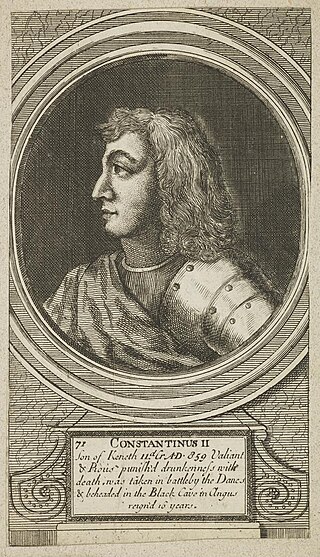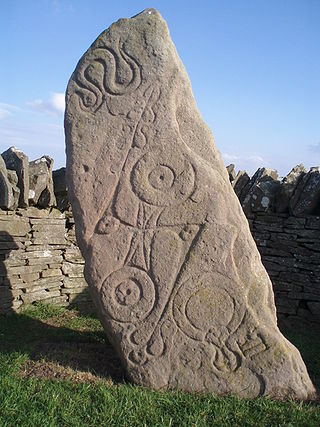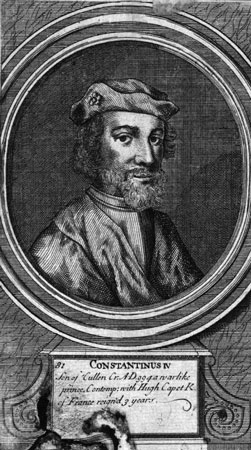Related Research Articles

Áed mac Cináeda was a son of Cináed mac Ailpín. He became king of the Picts in 877 when he succeeded his brother Constantín mac Cináeda. He was nicknamed Áed of the White Flowers, the wing-footed or the white-foot.

Causantín mac Cináeda was a king of the Picts. He is often known as Constantine I in reference to his place in modern lists of Scottish monarchs, but contemporary sources described Causantín only as a Pictish king. A son of Cináed mac Ailpín, he succeeded his uncle Domnall mac Ailpín as Pictish king following the latter's death on 13 April 862. It is likely that the reign of Causantín witnessed increased activity by Vikings, based in Ireland, Northumbria and northern Britain. He died fighting one such invasion.

Causantín mac Áeda was an early King of Scotland, known then by the Gaelic name Alba. The Kingdom of Alba, a name which first appears in Constantine's lifetime, was situated in what is now Northern Scotland.

Domnall mac Ailpín, anglicised sometimes as Donald MacAlpin and known in most modern regnal lists as Donald I, was King of the Picts from 858 to 862. He followed his brother Kenneth I to the Pictish throne.
Kenneth MacAlpin or Kenneth I was King of Dál Riada (841–850), and King of the Picts (848–858), of likely Gaelic origin. According to the traditional account, he inherited the throne of Dál Riada from his father Alpín mac Echdach, founder of the Alpínid dynasty. Kenneth I conquered the kingdom of the Picts in 843–850 and began a campaign to seize all of Scotland and assimilate the Picts, for which he was posthumously nicknamed An Ferbasach. He fought the Britons of the Kingdom of Strathclyde and the invading Vikings from Scandinavia. Forteviot became the capital of his kingdom and Kenneth relocated relics, including the Stone of Scone from an abandoned abbey on Iona, to his new domain.

The Picts were a group of peoples in what is now Scotland north of the Firth of Forth, in the Early Middle Ages. Where they lived and details of their culture can be gleaned from early medieval texts and Pictish stones. The name Picti appears in written records as an exonym from the late third century AD. They are assumed to have been descendants of the Caledonii and other northern Iron Age tribes. Their territory is referred to as "Pictland" by modern historians. Initially made up of several chiefdoms, it came to be dominated by the Pictish kingdom of Fortriu from the seventh century. During this Verturian hegemony, Picti was adopted as an endonym. This lasted around 160 years until the Pictish kingdom merged with that of Dál Riata to form the Kingdom of Alba, ruled by the House of Alpin. The concept of "Pictish kingship" continued for a few decades until it was abandoned during the reign of Caustantín mac Áeda.
Cináed mac Duib, anglicised as Kenneth III, and nicknamed An Donn, was King of Alba (Scotland) from 997 to 1005. He was the son of Dub. Many of the Scots sources refer to him as Giric son of Kenneth son of Dub, which is taken to be an error. An alternate explanation is that Kenneth had a son, Giric, who ruled jointly with his father.

Constantine, son of Cuilén, known in most modern regnal lists as Constantine III, was king of Alba (Scotland) from 995 to 997. He was the son of King Cuilén. John of Fordun calls him, in Latin, Constantinus Calvus, which translates to Constantine the Bald. Benjamin Hudson notes that insular authors from Ireland and Scotland typically identified rulers by sobriquets, noting for example the similarly named Eugenius Calvus, an 11th century King of Strathclyde.
Alpín mac Echdach was a supposed king of Dál Riata, an ancient kingdom that included parts of Ireland and Scotland.
Óengus mac Fergusa was king of the Picts from 820 until 834. In Scottish historiography, he is associated with the veneration of Saint Andrew, the patron saint of Scotland, although this has not been proven.

Giric mac Dúngail, in modern English his name is Gregory or Greg MacDougal and nicknamed Mac Rath, was a king of the Picts or the king of Alba. The Irish annals record nothing of Giric's reign, nor do Anglo-Saxon writings add anything, and the meagre information which survives is contradictory. Modern historians disagree as to whether Giric was the sole king or ruled jointly with Eochaid, on his ancestry, and if he should be considered a Pictish king or the first king of Alba.
MacAlpin's treason is a medieval legend which explains the replacement of the Pictish language by Gaelic in the 9th and 10th centuries.
The Chronicle of the Kings of Alba, or Scottish Chronicle, is a short written chronicle covering the period from the time of Kenneth MacAlpin until the reign of Kenneth II. W.F. Skene called it the Chronicle of the Kings of Scots, and some have called it the Older Scottish Chronicle, but Chronicle of the Kings of Alba is emerging as the standard scholarly name.
The Poppleton manuscript is the name given to the fourteenth-century codex probably compiled by Robert of Poppleton, a Carmelite friar who was the Prior of Hulne, near Alnwick. The manuscript contains numerous works, such as a map of the world, and works by Orosius, Geoffrey of Monmouth and Gerald of Wales. It is now in the Bibliothèque Nationale, Paris.
Drest was king of the Picts from 845 to 848, a rival of Kenneth MacAlpin. According to the Pictish Chronicle, he was the son of Uurad.
Conall mac Taidg was a king of the Picts from 785 until 789. Very little is recorded of the king. He is mentioned twice by the Irish annals, the most reliable source for the history of Northern Britain in the years around 800. He also appears in later regnal lists.

The origins of the Kingdom of Alba pertain to the origins of the Kingdom of Alba, or the Gaelic Kingdom of Scotland, either as a mythological event or a historical process, during the Early Middle Ages.
The Chronica Gentis Scotorum or Chronicles of the Scottish People was the first substantial work of Scottish history. It was written by John of Fordun, a priest of the diocese of St. Andrews and chaplain of the church of Aberdeen. Before his death, he had finished the first five books down to the reign of David I (1124–53) and had arranged his remaining materials, the last of which was dated 1385.
References
- ↑ Scottish Documents 100 (17), listed in London, National Archives, Lists and Indexes, no. 49 (1923), p. 102 (formerly London, Public Record Office, E39/100/170), from Chronicle of Huntingdon in the Encyclopedia of the Medieval Chronicle .
- 1 2 3 4 5 "Chronicle of Huntingdon". Encyclopedia of the Medieval Chronicle . Brill Publishers . Retrieved 17 Aug 2023.
- 1 2 3 Skene, W. F. (1867). Chronicles of the Picts, Chronicles of the Scots, and Other Early Memorials of Scottish History. Edinburgh: Edinburgh General Register House. pp. lix–lxi.
- ↑ "The returns made to these writs, which are still extant, contain numerous extracts and fragments of chronicles, which are printed by Sir Francis Palgrave in his Documents and Records illustrative of the History of Scotland published by the Record Commission." From Skene